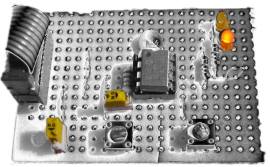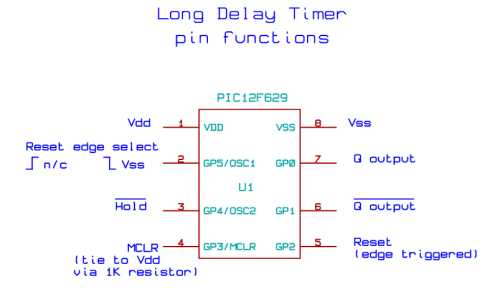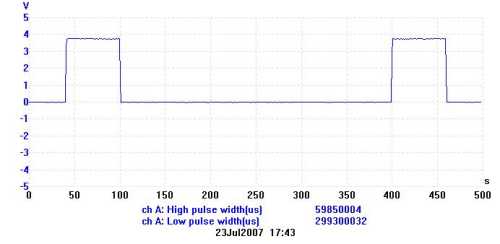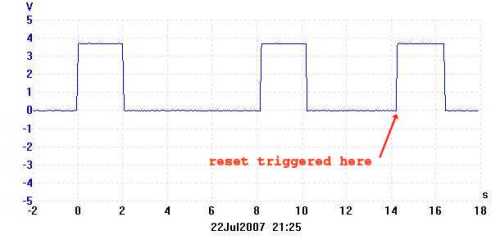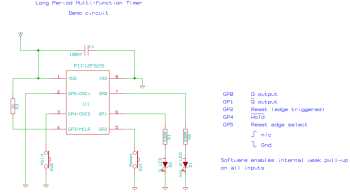Long Period Astable Timer with reset, hold and
|
|
Description
This software functions as a long period astable mutivibrator. The mark and space period can be set from 1 second up to a maximum 65535 seconds (18h12m15s). Using the internal 4Mhz RC oscillator delays with an accuracy of 99% or better can be achieved
The code also implements an edge triggered reset and an active low hold function. The reset edge can be configured for rising or falling edge. The hold function is active low and stretches the timed period for as long as the hold input is held low.
In addition to this up to 450 mark/space time pairs can be used which are executed sequentially allowing complex pulse trains to be generated.
By connecting the hold input to the Q output, the code can also be made to function as an edge-triggered monostable timer, using the reset input as the trigger.
The code will run on a PIC 12F629 or 12F675.
Pin functions
At power on and after an edge triggered reset the outputs enter a mark state with the Q output going high and the notQ output going low. The first time entry is then read and the code waits for the number of seconds specified. When this period has elapsed a Space state is entered with the Q output going low, notQ output high and the next time entry is read.
When the Hold input is taken low the output remains unchanged and the timer is stopped, effectively stretching the current time period. When the Hold input returns high, the timer continues.
If the Reset input is triggered while Hold is low, the outputs are reset to Q == high, notQ == low and the timer is loaded with the first entry from the LongDelayTimes.inc file. It them remains in the Hold state until the Hold input returns high.
Accuracy of timings
Since the timings are generated from the PICs internal 4Mhz RC oscillator the accuracy is subject to the tolerances specified in the Datasheet with respect to operating voltage and temperature. The software itself will generate an accurate timing but any deviation in the RC oscillator from 4Mhz will result in the time period deviating. You should therefore test the accuracy before committing it to an application.
Since the PIC calibration word can only be correct at a specific supply voltage and temperature it is advisable to calibrate it at the supply voltage it will operate at in the final application. This will help considerably in obtaining accurate timings.
My investigations with a number of PICs from different batches suggest that Microchip calibrate the PIC at a supply voltage of 3.5 volts. Therefore if you're operating it from a 5 volt supply it will be running slightly too fast.
In the trace below the factory calibration value was 0x2C, the value when recalibrated with a 5 volt supply was 0x34. For a programmed delay of 60 / 300 seconds it is showing 59.85/ 299.3 seconds which is 99.7% accurate. This would result in an error of 3m16s over 18h12m.
Software to recalibrate the internal oscillator in the 12F629/12F675 is described here
Example of time settings and output
Examples below illustrate the time entries in the 'LongDelayTimes.inc' file and the resulting signal on the Q output. The inverted signal is available on the notQ output.
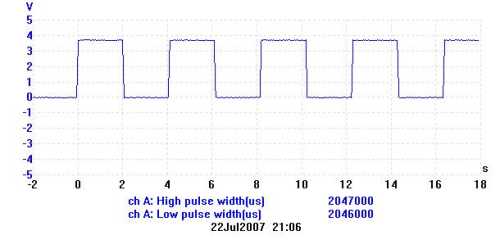
;---------------------------------------------------------------
; a single time entry generates
time 2 ; alternate marks and spaces with 50% duty cycle
;---------------------------------------------------------------With two entries, the first time value is the mark period and the second the space period.
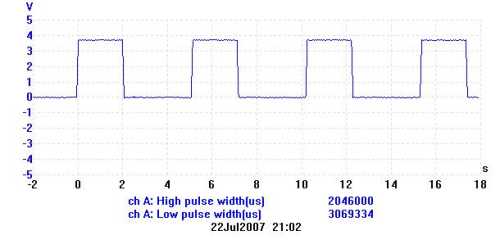
;---------------------------------------------------------------
time 2 ; mark
time 3 ; space
;---------------------------------------------------------------If you use a number of mark/space entries in the include file they are applied to the output sequentially before the whole sequence is repeated. This is illustrated below.
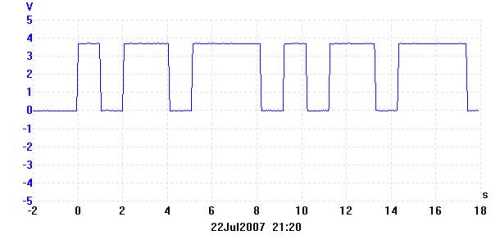
;---------------------------------------------------------------
time 1 ; mark
time 1 ; space
time 2 ; mark
time 1 ; spacetime 3 ; mark
time 1 ; space
;---------------------------------------------------------------
If you enter an odd number of time values then with each pass through the resulting marks and spaces in the output are inverted. This is illustrated below
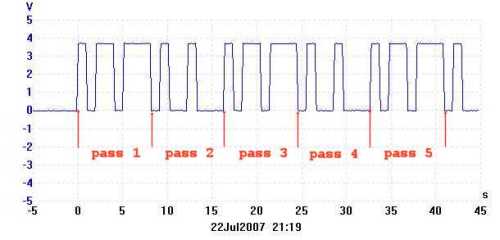
;---------------------------------------------------------------
time 1 ; mark / space
time 1 ; space / mark
time 2 ; mark / space
time 1 ; space / marktime 3 ; mark / space
;---------------------------------------------------------------When the reset input is edge triggered the output is immediately set to the Mark state and timing is restarted from the first entry in the include file. This is illustrated below
;---------------------------------------------------------------
time 2 ; mark
time 6 ; space
;---------------------------------------------------------------When the hold input is taken low, the output remains in its current state and the timer stops. When the hold input returns high, the timer continues. This is illustrated below.
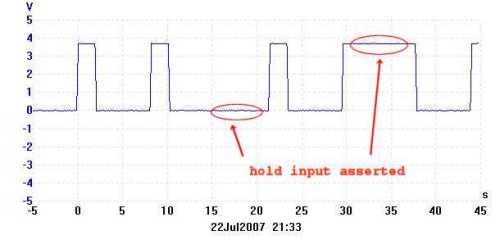
;---------------------------------------------------------------
time 2 ; mark
time 6 ; space
;---------------------------------------------------------------
This code is written for and will assemble for a 12F629 or 12F675 device using MPLAB.
There are two files, the main code is in LongDelayF5.asm and the timings are held in separate include file LongDelayTime.inc You will need to edit this file with your required timings before assembling the code.
Quick guide to re-assembling the code with MPLAB IDE can be found here.
Description Filename Download link Source code for 12F629/675 ldt_12_int.zip
v1.2.0 07/01/2009download
HEX file ready to program into the PIC* ldt_12_int.zip.HEX
v1.2.0 07/01/2009download
* The HEX file download contains a short demo sequence comprising 1S on - 2S off - 1S on - 3S off.
Floating Inputs
The weak internal pull-up feature is enabled for the reset, hold and edge select inputs so no external pull-up resistors are required. The MCLR input should by tied to Vdd using a 1K resistor.
Both outputs stay high
If both the Q and notQ outputs remain high after power-on, then the calibration word at program memory 0x3FF has been erased. For more information on the calibration word see here
برچسبها: حسین ملکی, پیام نور شیراز, مهندسی برق پیام نور شیراز, مهندسی پیام نور شیراز
دسته بندی : علمی

- اخبار/فعالیت های انجمن علمی برق
- علمی
- اخبار تکنولوژی
- کار عملی
- قطعات الکترونیکی
- دانلود
- ابزار آلات مهندسی برق
- نمونه سوال/ پیام نور/آزاد/غیر انتفاعی/دولتی/
- نرم افزار های مهندسی برق
- فرهنگی/حدیث/طنز/حجاب
- PLC
- آموزش گام به گام میکروکنترلر
- جمع آوری پروژه های میکروکنترلری
- مدارهای کاربردی آنالوگ
- کتب و جزوات مهندسی برق
- مجلات تخصصی و مقالات
- آموزش پروتئوس
- معرفی شرکت های صنعت برق و الکترونیک
- منابع تغذیه ،شارژرها و باطری ها
- نمونه برنامه ها میکرو به زبان c و درایور ها
- آموزش برنامه نویسی
- میکرو و معرفی پروگرامر های خوب/PIC/AVR/ARM/DSPIC/
- معرفی برد های آموزشی داخلی و خارجی
- فعالیت باحال برقی

بسیجی گمنام خمینی ٍ "" و لا یحمل هذا العلم الا اهل البصر و صبر و العلم به مواضع حق ""
و این پرچم مبارزه را جز افراد با بصیرت و صبور و آگاه به جایگاه حق به دوش نمی کشند .
این وبلاگ متعلق به گروهی از سربازان حقیقی حضرت بقیه الله الاعظم می باشد که در عرصه جهاد علمی و فرهنگی فعالیت می کند .
ایمیل : malekipcb@gmail.com


 نویسنده: بسیجی گمنام خمینی
نویسنده: بسیجی گمنام خمینی  چهارشنبه بیست و هفتم دی ۱۳۹۱ - 10:41
چهارشنبه بیست و هفتم دی ۱۳۹۱ - 10:41